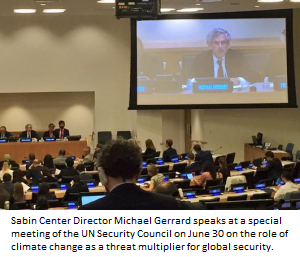Associate Professor of Law. Universidad Carlos III de Madrid (Spain)
Visiting Scholar at the Center for Climate Change Law (Columbia University)
Columbia’s Center for Climate Change Law has published a new white paper analyzing the Reverse Environmental Assessment tool for the adaptation of projects, plans and programs to the effects of climate change and, more specifically, evaluating the EU proposal for an Environmental Impact Assessment Directive. It is clear that mitigation measures are not enough to tackle climate change effects and, therefore, some adaptation measures will be needed to improve resiliency. The new Reverse Environmental Impact Assessment (REIA) analysis, so named by Professor Michael B. Gerrard, evaluates the impacts that the “transformed environment” -a result of the adverse effects of climate change- may cause to a project, plan, or program, in order to allow those undertaking these activities to act proactively.
The EU is aware of the need to incorporate adaptation measures into the climate change policy and for that purpose, it has elaborated:
- An Adaptation Strategy (April 2013), recognizing the importance of the Environmental Impact Assessment (EIA) for climate proofing; promoting greater coordination and information sharing among Member States, and ensuring the adaptation considerations are addressed in all relevant EU policies;
- A Climate-ADAPT benchmarking platform, to support EU countries in adapting to climate change, helping users to access and share information on climate change issues (vulnerabilities in European regions and sectors, adaptation strategies at National and transnational levels, case studies and potential options and planning tools that support adaptation planning); and
- Two Guidances on the integration of climate and biodiversity into either the Environmental Impact Assessment (EIA) or the Strategic Environmental Assessment (SEA) processes.
The EU has elaborated two different Directives that cover the Assessment in three levels: the project level, contained in the EIA Directive (Directive 85/337/EEC, amended in 1997, 2003 and 2009 and subsequently codified by Directive 2011/92/EU), and the national and sectoral levels, contained in the SEA Directive (Directive 2001/42/EU). According to the European Commission, the main difference between both tools is that in the SEA, the objectives are expressed in terms of sustainable development (therefore, considering the possible impacts from a holistic and inter-sector approach), taking into account all activity sectors that may be affected by the plan or program, whereas in the EIA, the aims are purely environmental, identifying the possible impacts of a specific project on it. The proposal for a Directive only referrers to Directive 2011/92/EU.
Regardless of its importance, and despite the inclusion of some references to the adaptation of the projects to climate change, the review of the Directive 2011/92/EU on the EIA does not make a clear commitment for the REIA tool, losing a great opportunity to introduce this new instrument into the legal systems of all EU Member States to really meet its goal of achieving a high level of environmental protection, adapting the EIA to new challenges, among others, climate change.
Indeed, the integration in the EIA of the challenges derived from climate change is included in the text of the proposal for a Directive (specifically in article 3 and Annexes III and IV), and, together with the EIA Guidance, takes into account the assessment of the eventual climate conditions that might affect a project (a real REIA) but with an unclear wording (or at least not as clear as it could have been, given the clarity of the Guidance to this respect). Therefore, and even though the proposal for an EIA Directive is a step forward in the right direction to climate-proof the EU policy, it could have been more effective for that purpose to include an explicit provision of the REIA analysis in the text of the proposal, as this tool soon will be (in fact it is today) essential and unavoidable for any EU action.
Photo credit: Guiseppe Milo (j0sh)




